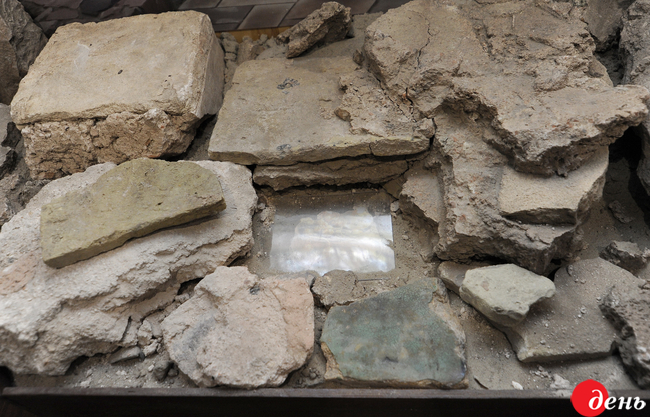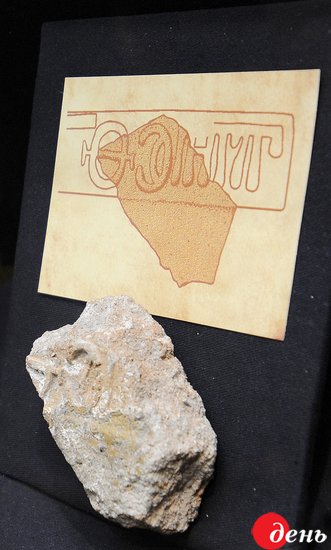“A popular and yet forgotten monument”
What can be done only in the Church of the Tithes History Museum
Ancient artifacts and exclusive archeological finds hidden behind glass panels of display cases, signs “Do not touch” or “Do not sit down,” the supervisor who protects the inviolability of the museum exhibition – these are familiar everyday realities of a museum. However, you will not find them in the Church of the Tithes History Museum. Two small rooms are all the space available for the permanent exhibition. One can handle every exhibit there, even plintha bricks dating back to the 10th century! It features the minimum number possible of classic display cases and offers maximum accessibility to everything that the museum employees have prepared for the revised permanent exhibition dedicated to the Church of the Dormition of the Virgin (Church of the Tithes), which is a monument of national importance.
The museum turns five this year. To mark that date, it has opened the exhibition which took almost nine months to prepare. What artifacts from excavations of the Church of the Tithes are kept there? What might be done solely by the Metropolitan of Kyiv in the past, but may be done by any guest of the museum now? The Day inquired into these secrets.
ONE SITE, THREE SHRINES
The Church of the Tithes had a tragic history. A church was erected on Starokyivska Hill on three occasions, but none has survived. The first shrine was built by Prince Volodymyr in 989-996. It was the first stone church of Kyivan Rus’. It met its ruin in 1240. Historians still argue about the proximate cause of the destruction of the church. Some say there were construction flaws, but the medieval chronicle’s version is as follows: the vaulted dome of the shrine could not stand the large number of people who took refuge in it during the Mongols’ assault on Kyiv.

At the initiative of Metropolitan Petro Mohyla, the Church of the Tithes’ foundations were cleared from rubble in the 17th century, and then a new church’s construction started. “The shrine of St. Nicholas of the Tithes did not last long, a hundred years at most. It gradually decayed, as it was partly built from wood, so time gnawed at it bit by bit,” we heard from Natalia Budzynska, the museum’s head of research and exhibition department. “Starting at the end of the 18th century, when active archeological work began, an interest in the Church of the Tithes reemerged. Metropolitan Eugene (Bolkhovitinov) was a lover of antiquity, known for his work in Old Rus’ archeology, and he ordered the Church of the Tithes ‘to be exposed to the daylight,’ as the period documents put it. Thus, the third church was built in 1842. It lasted less than a hundred years too.”
EXCLUSIVE INFORMATION FROM THE PAST
Previously, no Ukrainian museum told the story of all the Churches of the Tithes that were built in the oldest part of Kyiv on Starokyivska Hill, so the exhibition that has been opened here is unique. The exhibition’s own story was also a complicated one. In 2005-11, researchers of the Institute of Archeology of the National Academy of Sciences of Ukraine carried out excavations on the site of the shrine. The finds are kept at the Institute, and museum workers fruitfully cooperate with scholars, appreciate the items provided for the revised exhibition, and hope for further cooperation.

“Most importantly, our exhibition deals with all the Churches of the Tithes that once stood on Starokyivska Hill where the first shrine was built to celebrate the introduction of Christianity. Since the museum is small, we were looking for unusual ways of creating the exhibition so as to make it spectacular and interactive,” said Natalia Pysarenko, the acting director of the Church of the Tithes History Museum, while pointing to a 10th century plintha brick carrying an Ancient Greek-inscribed stamp. “And this is a copy of a late 10th century fresco, its original held by the Institute of Archeology. Such large fresco was found for the first time ever, and it definitely comes from the Old Rus’-era Church of the Tithes. The copy’s size is equal to that of the original fresco. They used a special technique for restoration involving pasting paints on bandages.”
GIFTS FROM COLLECTORS
The museum is low on original exhibits, but the few extant ones are worth mentioning. In particular, we mean a book published in Metropolitan Mohyla’s time and 17th century crosses found during recent excavations. Also, how wonderful are photos of “Stasov’s church” (the folk name of the third shrine, coming from the name of its architect Vasily Stasov)! By the way, the architect was born in St. Petersburg and took the Kazan Cathedral of his hometown as a model for the future shrine. Iconostases of both churches are identical. A photo of “Stasov’s church,” which Kyivites often chose for their weddings and christenings, can be viewed through a stereoscope made in the 19th century.

“Many exhibits have been provided by collectors. For instance, a Kyivite donated a family album with photos of the Velmin family,” Budzynska continued. “Petro Velmin served as the parish priest of ‘Stasov’s church.’ He was the father of Serhii Velmin who participated in the excavation of the Church of the Tithes in 1908-14 while still a university student. This is the link between the album and our museum. This album even includes photos of the excavations of ‘Stasov’s church.’”
“ATTRACTIONS” FOR TOURISTS
How did the Divine Liturgy sound in the Church of the Tithes? What the treasure chest, holding Mohyla’s donations for restoration of the ancient shrine, looked like? One can hear and see it all for themselves at the museum. By the way, the chest stands where the valuables should be kept, that is, in the actual safe which museum workers have used as an exhibition location. If you want to make a puzzle from marble blocks which once covered the Church of the Tithes’ floor, you are welcome to do it using the museum’s replica blocks.

By the way, the greatest treasure to be ever found in Kyiv was discovered during an excavation of the Church of the Tithes in the 1820s. Museum visitors can ‘find’ it again. Stones from the church excavation sites are stacked near one of the walls of the exhibition hall. If you are lucky enough to lift the right stone, you will see a jewel-decorated pitcher... It may be just a drawing, but then it may be something more...
Museum workers call such unusual exhibiting methods “attractions” for tourists. One of them is the omphalion, reproduced in the center of the exhibition hall. In the Church of the Tithes, it was paved with different types of stone. It was a sacred part of the shrine’s floor, and only the highest church hierarchy might stand on it. Meanwhile, every visitor of the museum is welcome to do it now.
“THE MUSEUM NEEDS RECOGNITION”
The museum has a lot to show, to discuss, and to ponder. Its team aims to expand the museum space and enrich the collection. “Our dream is to collect all the exhibits that are related to the Church of the Tithes, wherever they might be now. At least, we need to photograph them and make a video sequence,” Pysarenko explained. “Excavation finds of different periods have been scattered throughout the world, they were just packed in crates and carried off. Russia is not returning anything now, and they hold most such exhibits, while some are kept in New York. Returning anything is almost impossible.”

The museum employees also tell the latest news on the Church of the Tithes, which is the tracing of its foundation, which took place in 2015 and involved the NGO Andriivskyi-Peizazhna Initiative. The researchers say that museification would be a better choice, but it would require huge resources. Since there was a risk that the Ukrainian Orthodox Church (Moscow Patriarchate) would build a shrine over the monument, the museum accepted the tracing proposal.
Despite its cramped conditions, the museum’s employees do a great job, as they deliver lectures and organize quests and trips to the location where the Old Rus’ church once stood. Meanwhile, the institution receives funding which covers only rent, salaries, and utility bills. “We agree to work on such terms, but the museum needs recognition,” Pysarenko added. “This institution has done a lot, and we now want to see it appreciated. After all, the Church of the Tithes is a popular and yet forgotten monument.”






